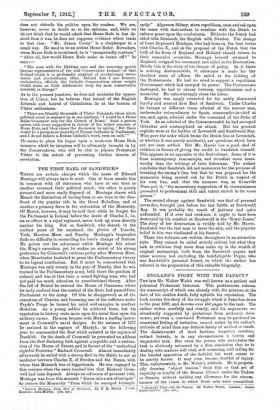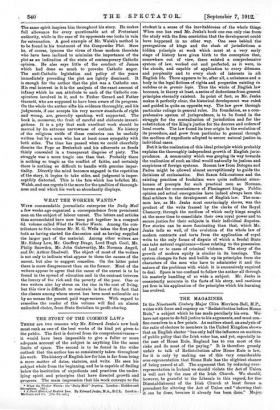ENGLAND'S FIGHT WITH THE PAPACY.* THE late Mr. Walter Walsh
was well known as a patient and polemical Protestant historian. This posthumous volume, the manuscript of which was already with the printers. at the date of his sudden death, fully upholds his: reputation. The book carries the story of the struggle which it describes down to the year 1688, and devotes over 450 pages to the task. The author writes carefully and clearly, and his arguments are abundantly supported by quotations from authentic docu- ments, yet even a convinced Protestant may be pardoned an occasional feeling of irritation, caused rather by the author's attitude of mind than any definite falsity of method or result. The disinterment of dead factions, forgotten cruelties, extinct hatreds, is in any circumstances a barren and ungrateful task. But when the person who undertakes the task is obviously animated by a firm conviction that he is dealing with matters etill vital, still menacing, still calling for the banded opposition of the faithful, his work ceases to be merely barren. It may even become fruitful of injury. This, unfortunately; is Mr. Walsh's attitude. He is perpetu. ally drawing "object lessons" from this or that act of duplicity or cruelty of the Roman Church under the Tilden or Stuarts, without making any allowance for the circum- stances of the times in which these acts were committed.
* Ragiandfs Right with Ms Papacy. By Walter Walsh. Landon: James
Nisbet and Co. 115s. net.] .
The same spirit inspires him throughout his story. He makes full allowance for every questionable act of Protestant authority, while in the case of its opponents one looks in vain for extenuation. A good example of Mr. Walsh's method is to be found in his treatment of the Gunpowder Plot. Here he, of course, ignores the views of those modern theorists who have been inclined to minimize the importance of the plot as an indication of the state of contemporary Catholic opinion. He also says little of the conduct of James which had done so much to provoke Catholic anger. The anti-Catholic legislation and policy of the years immediately preceding the plot are lightly dismissed. It is enough for the author that the plot was a Catholic one. His real interest in it is the analysis of the exact amount of infamy which he can attribute to each of the Catholic con- spirators involved in it, and to Father Gerard and Father Garnett, who are supposed to have been aware of its progress. On the whole the author sifts his evidence thoroughly, and his judgments, if one accepts his very narrow standards of right and wrong, are, generally speaking, well supported. The book is, moreover, the fruit of careful and elaborate investi- gations. It is a pity that such excellent work should be marred by its extreme narrowness of outlook. No history of the religious strife of these centuries can be usefully written but by a man who has at least some sympathy with both sides. The time has passed when we could cheerfully dismiss the Pope as Beelzebub and his adherents as fiends thinly concealed in a transparent disguise of piety. The struggle was a more tragic one than that. Probably there is nothing so tragic as the conflict of faiths, and certainly there is nothing so difficult to handle with genuine impar- tiality. Directly the mind becomes engaged in the repetition of the story, it begins to take sides, and judgment is imper- ceptibly distorted. This is the fate which has befallen Mr. Walsh, and one regrets it the more for the qualities of thorough- ness and zeal which his work so abundantly displays.







































 Previous page
Previous page